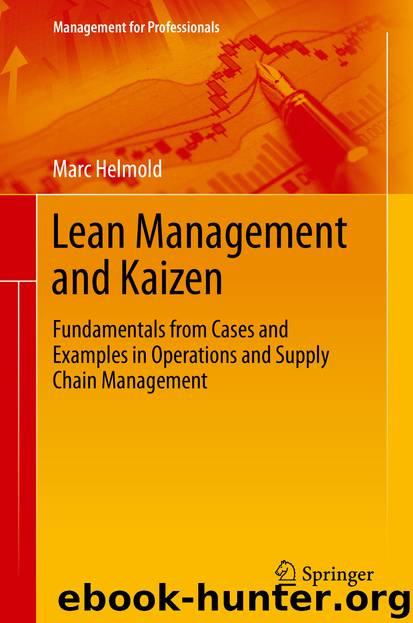Lean Management and Kaizen by Marc Helmold

Author:Marc Helmold
Language: eng
Format: epub
ISBN: 9783030469818
Publisher: Springer International Publishing
Fig. 10.2Porter’s value chain. (Source: Author’s source, adopted from Helmold et al. (2020))
In their research “An Empirical Analysis of the Effect of Supply Chain Disruptions on Long-Run Stock Price”, found that enterprises without operational slack and redundancies in their supply chains experience negative stock effects. The authors revealed the tremendous impact of supply chain disruptions on stock price performance and shareholder value. Supply disruptions can easily lead to high recovery cost, waste, and sharp decreases in sales. External customers become dissatisfied, and internal core functions (e.g. assembly) are disturbed. In most cases, supply disruptions have negative impacts on brand image, sales figures, and the company’s own financial situation as stressed by many authors writing about supply disruptions and resilient supply chains (Trkman and McCormack 2009). Recent incidents in the media about disruptions caused by upstream supply management inefficiencies from China show that the supply management excellence approach needs to tackle these issues in a proactive and sustainable way.
Supply management risks have mainly been investigated at the direct level of tier one relationships, but consideration has not been fully extended to sub-suppliers, i.e. tiers one, two, three, and beyond. The new concept of supply management therefore seeks to address these concerns by investigating how disruptions can be anticipated, prevented, and managed over the entire value chain including all tiers on the supply and demand side as shown in the figure by Slack et al. (1995). Recent supply disruptions show that current supply management organizations, tools, and concepts are not smart and resilient enough to avoid these supply chain discrepancies. Recent articles, for example, in the magazine Automotive News, show that all car producers are facing severe problems due to suppliers’ problems. Not only the automotive industry but also many other industries face these issues.
The lean supply management concept was developed by Ohno (1990), who worked for Toyota Motors. It derived from a bundle of instruments which come from sophisticated production methods or supporting functions such as logistics. The ideal interplay and optimal combination of all instruments are essential for success. The vision of lean production is based on the just-in-time (JIT) philosophy and the Toyota Production System (TPS : Japanese = トヨタ生産システム) and focuses on the elimination of waste and the minimization of stock.
Download
This site does not store any files on its server. We only index and link to content provided by other sites. Please contact the content providers to delete copyright contents if any and email us, we'll remove relevant links or contents immediately.
International Integration of the Brazilian Economy by Elias C. Grivoyannis(98741)
The Radium Girls by Kate Moore(11970)
Turbulence by E. J. Noyes(7977)
Nudge - Improving Decisions about Health, Wealth, and Happiness by Thaler Sunstein(7655)
The Black Swan by Nassim Nicholas Taleb(7054)
Rich Dad Poor Dad by Robert T. Kiyosaki(6510)
Pioneering Portfolio Management by David F. Swensen(6253)
Man-made Catastrophes and Risk Information Concealment by Dmitry Chernov & Didier Sornette(5952)
Zero to One by Peter Thiel(5730)
Secrecy World by Jake Bernstein(4698)
Millionaire: The Philanderer, Gambler, and Duelist Who Invented Modern Finance by Janet Gleeson(4418)
The Age of Surveillance Capitalism by Shoshana Zuboff(4243)
Skin in the Game by Nassim Nicholas Taleb(4200)
Bullshit Jobs by David Graeber(4137)
The Money Culture by Michael Lewis(4130)
Skin in the Game: Hidden Asymmetries in Daily Life by Nassim Nicholas Taleb(3960)
The Dhandho Investor by Mohnish Pabrai(3722)
The Wisdom of Finance by Mihir Desai(3693)
Blockchain Basics by Daniel Drescher(3538)
